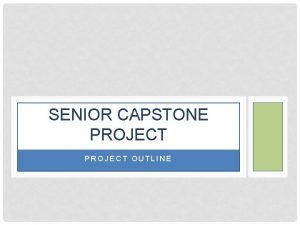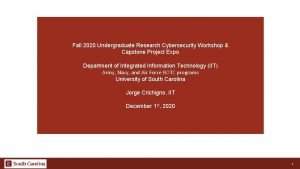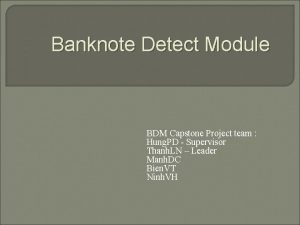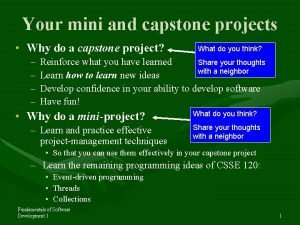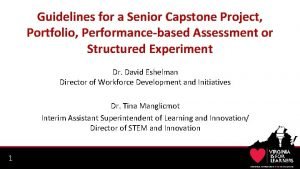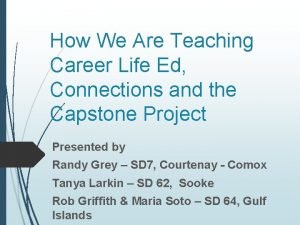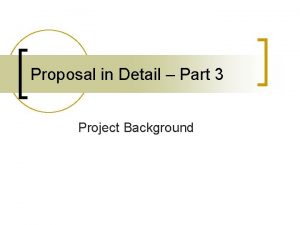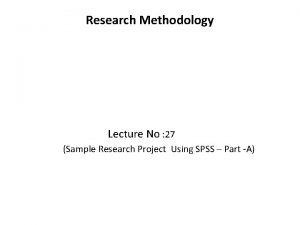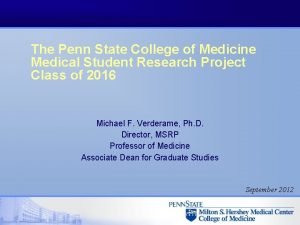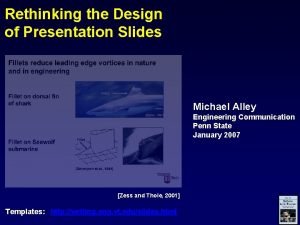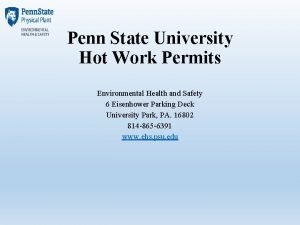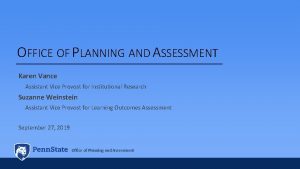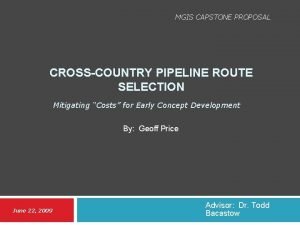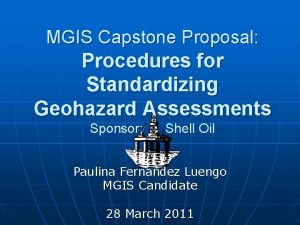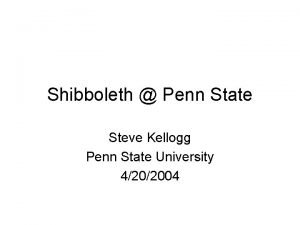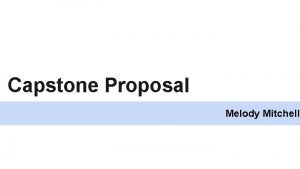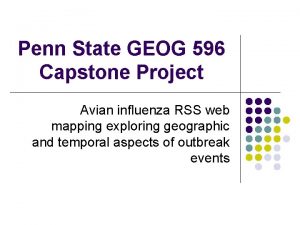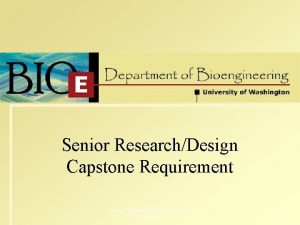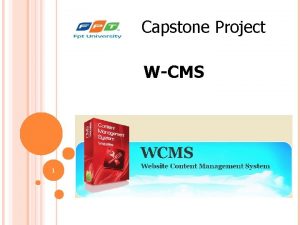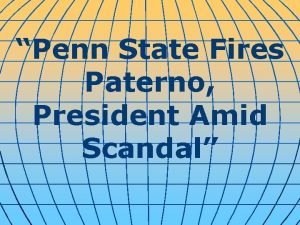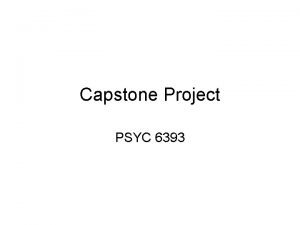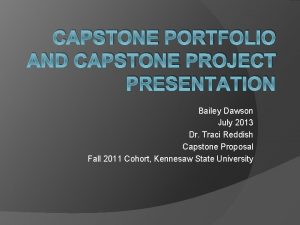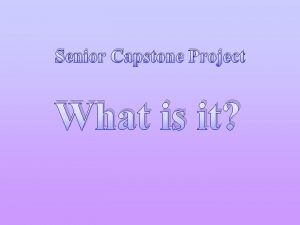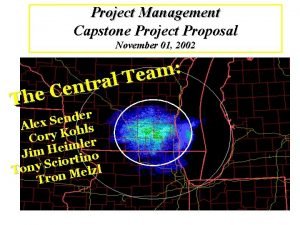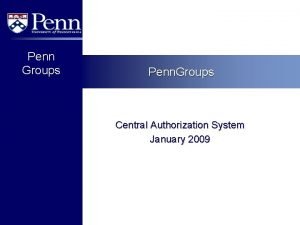Penn State University MGIS Program Capstone Project Proposal























- Slides: 23

Penn State University MGIS Program Capstone Project Proposal Peer Presentation: Creating a Spatial Analysis Model for Generating Composite Cost Surfaces to Depict Cross Country Mobility in Natural Terrain Andrew Grogan (MGIS) Advisor: Dr. Peter Guth USNA April 20 th 2009

Introduction Creating a Spatial Analysis Model for Generating Composite Cost Surfaces to Depict Cross Country Mobility in Natural Terrain 2

Objective To create a spatial analysis model which generates standardized Cross. Country Mobility (CCM) cost surface data depicting the ease or difficulty of vehicle movement in natural terrain for a designated area of interest. 3

Goals Project Focus Ø Applied spatial analysis model Ø Requires moderate GIS savvy Ø Customization: I. Seasonal II. Temporal III. Unique Ø Modernize US Army Mylar Overlay Process 4

Objectives Key Components: Ø Composite Cost Surfaces from Themes. Ø Standardized Classification. Ø Adaptable to any AOI. Ø Flexibility for Input and Output. Ø Cost Surfaces facilitate further spatial analysis (LCP/CD). Ø Cost Surfaces used to generate semantic data and hardcopy maps. 5

Background Military Geography Definitions “The application of geographical principles and knowledge to the solution of military problems. ” (Jackman 1962) “It (Military Geography) links geography and the military science, and is a type of applied geography, employing the approaches, methods, techniques and concepts of the discipline to military affairs, places and regions. ” (Palka 1995) “Geospatial intelligence (GEOINT) is the exploitation and analysis of imagery and geospatial information to describe, assess, and visually depict physical features and geographically referenced activities on the Earth. ” (US Army FM 3 -24, 2006). 6

Background US Army Geospatial Terrain Analysis Development History “In 1972 the Defense Mapping Agency (now NGA) was formed from the Army, Navy and Air Force mapping and charting operations to consolidate map production and distribution for all branches of the military. ” (Bacastow, Peuquet 1991) “In the 1980 s the U. S. Military finally recognized the need for routine input of terrain analysis for staff planning. Each army division and Corps has an organic engineer terrain-analysis team assigned. ” (Guth 1998) Logos used for educational purposes only 7

Background US Army Geospatial Terrain Analysis Development History US Army Terrain Units “In concept, the role of the Army’s topographic field units is to provide tailored support for the field decision maker through synthesis, transformation, update and quick emergency substitutes when DMA data are not available or insufficient. ” (Bacastow, Peuquet 1991) Unit Functions Include*: Ø Creating terrain analysis products to support military operations Ø Creating Tactical Decision Aides (TDAs) based on operational variables Ø Pulling existing data from appropriate sources, creating TDAs and pushing products to end users. * CTIS Terrain Analysis Fact Sheet 2009 8

Background Military Operations Other than War (MOOTW): Ø Humanitarian Assistance Ø Peacekeeping Ø Nation/Security Assistance Ø Noncombatant Evacuation Ø Disaster Relief Ø Support of Domestic Civil Authority Ø Counter-drug Operations Ø Arms Control US Army Corps of Engineers Assisting a Trapped Motorist. For Educational Purpose only Ø Combating Terrorism Palka 1995 9

Target Users Military Users: Ø US Army Terrain Analysis Teams Military Applications: Ø Ø Combat Operations - Tactical Decision Aides (TDAs) I. Spatial Analysis: Least Cost Paths and Cost Distances. II. Semantic Data Generation: Avenues of Approach, No-Go Areas , Key Terrain, Barriers/Obstacles, Chokepoints. Military operations other than war (MOOTW) I. Spatial Analysis - Military Land Management, Environmental Impacts. 10

Target Users Civilian Users: Ø Academic and Private Users Civilian Applications: Ø Search and Rescue Operations: I. Ø Spatial Analysis: Least Cost Paths and Cost Distances. Land Management I. Spatial Analysis - Public Land Management, Environmental Impacts, Suitability/Capability for Land Use, Off-Road Vehicle Impacts. II. Generation of Semantic Map Data for Presentations 11

Technical Approach Model Development Ø Evolution From Manual Process Ø Uses ESRI’s Model. Builder Ø Based on FM 5 -33 and NATO Reference Mobility Model II (NRMM) (Birkel 2003) 12

Technical Approach NATO Reference Mobility Model II (NRMM)*: Ø Developed in the 1970’s Ø Collection of Mobility Sub-Models Ø Predicts Physically Constrained Terrain Ø Calculates General Rates of Movement Limitations: Ø Focus on Force Controlled Speed Ø Time Constraints not Ease/Difficulty of Mobility Ø Engineering Point of View Ø Not a GIS solution *(Birkel 2003) 13

Technical Approach US Army Field Manual 5 -33 Defines: Ø Traditional Mylar Overlay Process Ø Terrain Data Themes Ø Thematic Data Classification Scheme Ø Thematic Data Impact on Vehicle Movement Ø Inter-Theme Relationships Ø Analytical Approaches 14

Area of Interest AOI for Proposed Model Development Ø Representative Area of Interest (~ 2000 Km 2) Ø Southern Arizona I. Horst and Graben (Basin and Range) II. Desert Scrub, Riparian Zones, High Mountain Alpine Terrain 15

Data Resources 16

Technical Approach Creating Composite Cost Surfaces ØData Classification Ø Map Algebra Ø Smoothing Algorithm 17

Objectives Using GIS to Improve CCM Cost Data: Ø Prevent Bin Category “Stepped” Data Values Ø Provide Smoothed Cost Surfaces Ø Improve CCM Data Depiction 18

Methodology 19

Methodology 20

Limitations Possible Restrictions and Limitations Ø Pre-Model Data Preparation Required I. Unique Data Aspects II. Dataset Variance III. Data Equivalency Ø Model Limited to Select Thematic Variables Ø Trial and Error approach Required Ø Requires Adaptive Optimization (Smoothing Algorithm, Order of Operations) 21

Anticipated Results Ø Composite CCM Cost Surfaces Ø Multi-Thematic Representation Ø Increased Level of Detail Ø Reproducible Results Methodology Ø Basis for Further Spatial Analysis (Least Cost Paths/Cost Distances) Ø Base Layer for Semantic Data Extraction and Depiction. Ø CCM Depiction for Spatio-Temporal Events 22

Questions ? Andrew Thomas Grogan atg 153@psu. edu 23
 Penn state mgis
Penn state mgis Sample capstone project outline
Sample capstone project outline Penn state harrisburg psychology
Penn state harrisburg psychology Global penn state
Global penn state Penn state meteorology jobs
Penn state meteorology jobs Mgis 317 study guide
Mgis 317 study guide Middle school capstone project ideas
Middle school capstone project ideas Cybersecurity capstone
Cybersecurity capstone Culinary capstone project
Culinary capstone project Bdm capstone project
Bdm capstone project Mini capstone project
Mini capstone project Java capstone project
Java capstone project Capstone project
Capstone project Capstone project portfolio
Capstone project portfolio Career life connections capstone project examples
Career life connections capstone project examples Project background for project proposal example
Project background for project proposal example Methodology of project proposal
Methodology of project proposal Msr penn state
Msr penn state Michael alley penn state
Michael alley penn state Qualtrics penn
Qualtrics penn Ehs penn state
Ehs penn state Penn state neurosurgery faculty
Penn state neurosurgery faculty One penn state 2025
One penn state 2025 Psu factbook
Psu factbook

